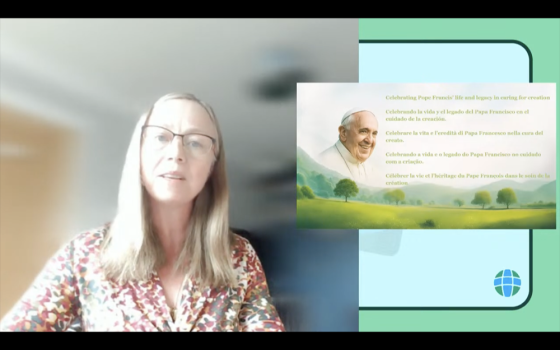
Worship & Liturgy
What does it mean to be Catholic? There are probably as many answers to that question as there are Catholics. My own fascination with the identity question began, like most fascinations, in autobiography. I was educated by French nuns in a private girls’ school. Academics were rigorous and there wasn’t much free time in the daily routine.
Except for one miraculous loophole that had escaped the sharp gaze of Reverend Mother: the chapel visit. During the last study hall of the day, we could visit the chapel. That meant waving a small square of black lace veil at the presiding sister, getting her nod, then escaping, unsupervised and independent, for the long walk down a hall filled with swooshing ferns and lined with huge windows. The gleaming wood floors made a fitting approach to the transcendent. There, a thoughtful person could transition from academic drudgery to sacred space.
Oddly enough, we didn’t go simply to escape study. Perhaps brighter students had figured that out, but I went for the peace and beauty of that chapel. Half a century later, I can still visualize its soaring white arches, its columns carved with intricate designs. Ivory marble predominated, anchored by glowing jewels of stained glass and the polished surfaces of wooden pews. Getting A’s in religion now seems less relevant than that lovely setting.
Those hushed and hidden moments in the chapel began a lifelong love affair. I didn’t know then that my personality type is intensely drawn toward beauty. I didn’t realize how much an introvert needed a peaceful oasis in a day packed with interactions. Nor did I dream that my career in spirituality would one day lead back to the beginning.
But I began to connect the dots when I spoke to friends about similar, early experiences in Catholic schools. Artist Michael O’Neill McGrath, an Oblate of St. Francis de Sales, dismayed by the academics of the classroom, delighted in the stained glass windows of the church. Even as a first-grader, he was itching for drawing paper and crayons, which foretold his stunningly creative career.
Dominican Fr. Paul Colloton, director of education for National Pastoral Musicians, doesn’t remember much about his classroom experience. But he glows with delight at the memories of choir. In that arena, he came alive, foreshadowing his career as a liturgist and musician. All three of us had a window.
Our examples may not be true for everyone, but they suggest an interesting trend. In the question of Catholic identity, what some consider a side dish is indeed the main course. Many who have forgotten the precepts of the church or the essentials of transubstantiation remain faithful to the poetry of the faith: the smells and bells, the art and decoration, the saints and incense.
Indeed, Fr. Andrew Greeley, a sociologist who has studied fidelity to the church, writes: “Catholics stay in their church because of loyalty to the imagery of the Catholic imagination, because of the spiritual vision of Catholics that they absorb in their childhood along with and often despite all the rules and regulations that were drummed into their heads.”
Which brings us to the question of narrow box or big window. Many people define Catholics in terms of what we oppose: abortion, gay marriage, the death penalty, to name a few controversies. While those are important pieces, they don’t create the whole picture. Nor is Catholicism simply cerebral. While study forms the strong spine of our theology, a larger dimension is accessible to those who may not be academically inclined. What, then, are we?
Being Catholic means being steeped in a way of life. It means finding God at every turn: in candlelight or conversation, night sky or green meadow. No matter how small or even oppressive our environment may seem, we can look beyond or within it for a hidden dimension: the elusive, mysterious presence of God.
All around us are signs, gifts from God. To read them aright, we need to interpret the language of symbol.
Or, to stay with the metaphor, we need to open the windows for a larger perspective on human life: its divine element.
How do we best prepare children for this way of life, teaching its language, sensitizing to its nuances?
As St. Ignatius directed, we go in through their door. Children are naturally attuned to the small miracles of creation: an intriguing insect, a puddle made for mirroring and splashing, an unusual cloudscape. They are concrete-minded, so abstractions have far less meaning than teachings grounded in sensate reality.
As the botanist Luther Burbank says: “Every child should have mud pies, grasshoppers, water bugs, tadpoles, frogs and mud turtles, elderberries, wild strawberries, acorns, chestnuts, trees to climb, brooks to wade in ... bats, bees, butterflies ... sand, snakes ... and any child who has been deprived of these has been deprived of the best part of education.” Lucky the child who knows the next level: that the grasshopper is a symbol of John the Baptist and the beehive of the Christian community.
The best of Catholic worship accords with that.
As the Book of Wisdom says, our delight in natural beauties guides us to their source, the author of all beauty. So the Advent fragrance of candles nestled in evergreen, the blaze of bonfire at the Easter Vigil, the splash of holy water, or the story of Jesus’ post-Resurrection barbecue beside the lake open the window through our senses to our eternal heritage.
Of course we must continue to teach the content of the faith: the Gospels, social teachings, traditions with both capital and small “t.” But let’s also pay keen attention to the environment in which we teach that faith. Anyone who remembers the insufferable boredom of childhood -- the endless days of nothing to do -- knows the importance of feasts and fasts, snacks and treats, saints and stories, all open windows. Pope John XXIII evoked that image when he called the Second Vatican Council to let in some fresh air.
Are children in Catholic classrooms, whether parish schools or religious education programs, surrounded by symbol, color, art, statues that mirror their ethnicity, our finest music, our noblest saints, our most intriguing legends? Are we deliberate in our liturgies about using real candles, not the phony electric ones, genuine plants, not plastic greenery? Can we identify the turning of liturgical seasons by the choreography of colors? Have we forgotten the evocative play of incense and music?
Or have churches and classrooms become sterile vacuums without windows to invite the play of imagination? In our efforts to educate businesspeople and competent bureaucrats, are we neglecting the potential of budding artists and saints? Are we feeding peoples’ spirits and senses, as well as their consciences and minds?
We need to feed everyone, not just potential artists, poets and musicians, with the same rich mix that fed the saints. In contrast, popular culture is thin gruel indeed. Christians have mountains to climb and a world to transform. They can’t do that on a diet of Pop-Tarts.
Catholics should be celebrating the saints’ feasts, the liturgical seasons, multicultural customs, using decorations that aren’t fluff but mirrors of God’s image, icons into heaven. The root word for decoration in Latin is decus, which means “fitting.” As Peter Mazar writes in School Year Church Year: Customs and Decorations for the Classroom: “a real decoration makes the classroom a window into mystery.”
The early Christians, like ourselves, lived among many different cultures and belief systems. They had to compete, as we do, with other voices that appealed to their young. They couldn’t hoard a treasure: They needed to display it openly for all to admire, with their finest language, loveliest hymns and most beautiful art.
Nor were they threatened by the presence of other beliefs and value systems jostling for attention. St. Thomas Aquinas voiced this respect: “All that is true, by whomsoever it has been said, has its origin in the Spirit.” The first disciples simply stood in their own truth, presenting it as well as they could, hospitably welcoming others to share. As our children grow up with multiculturalism, we’d be wise to model their stance.
[Kathy Coffey, author of numerous books, works as an editor and gives workshops nationally.]



